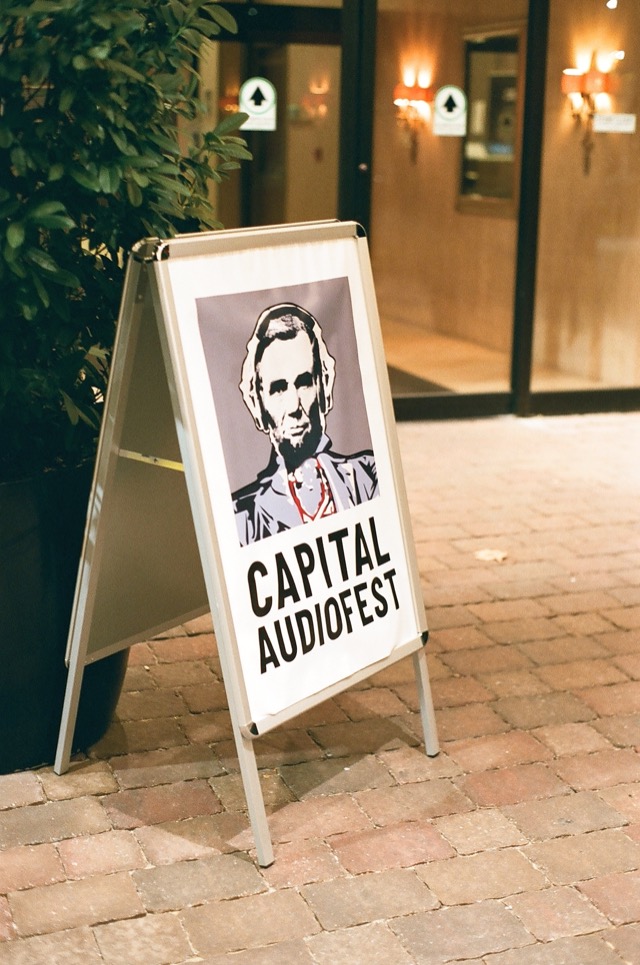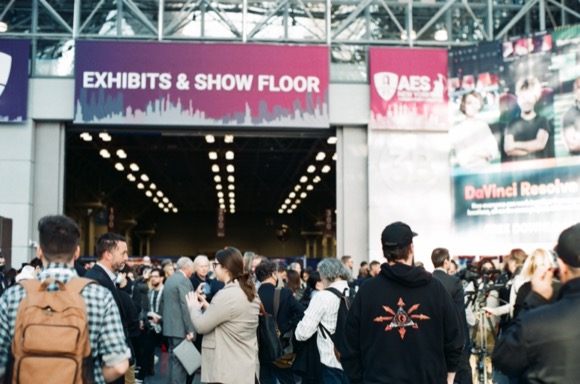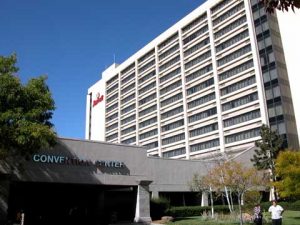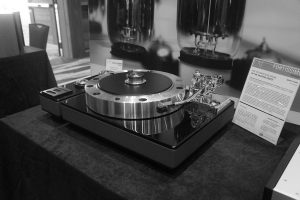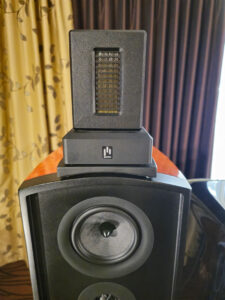The Audio Engineering Society has a big event every year that alternates between the east and west coasts of the US. What makes it interesting is that it's both a big trade show upstairs and an academic conference with papers downstairs. This makes it much more interesting than most audio events because it brings in both the engineering and the marketing people and watching them interact is worth the price of admission right there.

Every year I go and write it up for PF, and this year some things were a bit different as they seem to be contracting a lot of the event out now. I'll talk about this a bit later.
Paper Note
Before starting let me say that there were far fewer papers than are normally presented at the show (and for some bizarre reason they were listed as "lectures" on the schedule). They are broken out individually on the schedule instead of just listed in blocks, which is definitely good, though.
Last year the registration was a disaster, and they were also trying a third tier of admission which allowed access to some paid events but not papers. I think that third tier was a mistake. This year we were back to two levels, the Exhibits+ which got access to some workshops and educational events, and some special events, and the All Access badges which could get access to all papers and workshops as well. It still was not always clear to attendees what the Exhibits+ would get them into. A lot of them had no idea that they could attend the Heyser Lecture with an Exhibits+ badge. It might actually be good to have the schedule break out which level of badge you need for which event so people could plan better in advance.
They also did a much better job of posting schedules at each of the workshop rooms, although it really would have been good to have printed out posters of the full schedule up in the hallway somewhere. I also notice that a lot of papers got added in the last week, so the printout I had made from the website before I left was out of date by the time the show started. So what was there?
Speakers
Fluid was showing a three-way reference monitor system using a Heil ESS-type driver with a short waveguide on the top end and extensive internal DSP. I couldn't tell what it was like given the high levels of noise on the show floor but it's good to welcome a new entry into the monitor world.
A company called "KII" had a booth without anything in it. They had some brochures for the "KII Seven Wireless Music System" which appeared to be a remote bluetooth speaker. But they didn't actually have any speakers or people in their booth, just an unattended poster and some handouts. I felt like something had gone wrong.
Years ago there was a large number of sound reinforcement vendors at the show, with a lot of demos and a good bit of floor space. That hasn't been the case for ages but I was pleased to see TT+ Audio with their new GTX line arrays. If you're looking for good sound control in a large auditorium or trying to get even coverage in a stadium you might want to look at this stuff. It seems well-engineered and easy to work with.
Grimm Audio was showing their LS1 series loudspeakers, which are very neutral reference-grade monitors. Designed for accuracy and neutrality rather than for having a huge amount of headroom, they are intended for the mastering room but would be excellent in a high-end home system as well. Grimm was also showing their UC1 universal converter which is a sort of line preamp for the modern digital world, with analogue inputs and outputs and the ability to drive multiple analogue or digital monitors. It was very interesting seeing Grimm here and then seeing them a few weeks later at the Capital Audiofest and seeing the difference in what they were presenting.
Audio Alchemist was showing off some speakers made by Ex Machina in Brooklyn, using SEAS coaxial drivers on top and additional woofers. These are very heavily DSP-based with a lot of crossover processing, and that kind of thing can be either good or bad and you can't tell on the show floor. So if you ever have an opportunity to try these in a good environment they are worth trying.
On the exact opposite end of the spectrum, the folks from Auratone were there showing the modern active version of the Auratones. Auratones, sometimes known as "Horrortones" were intended as cuing monitors back in the seventies but developed a large following by people who were using them as check-mix monitors to hear what their audio would sound like on a small TV set speaker. They are still useful tools for that and I am pleased to see them back in production again with a new refinements that make them easier to use in a modern environment.

Triad-Orbit was showing some articulated speaker mounts that can be attached to walls. Not necessarily what you want for your main speakers where you need to be able to adjust the distance forward and back, but very useful for surround speakers, and in the multichannel object-oriented world where we may have a large number of individual speakers this sort of thing can be very handy. They are selling them under the "Precision Speaker Mount" line.
The one speaker paper I went to was a very interesting one. In The Watkins Woofer by Sebastian Degraeve and Jack Oclee-Brown, they discussed a woofer configuration designed in the seventies by Bill Watkins at Infinity. This uses a dual-coil woofer where audio signal is provided directly to one coil, while a filter is applied to the signal on the second coil so that it is only energized over the driver resonance point. This allows a closed box woofer to have slightly better efficiency with no real disadvantage. The configuration is a good one and has been used in the past but never actually analyzed. The authors provide a good and complete mathematical model for the system which matches well with the actual system performance. This model could be a useful guide for constructing crossover filter circuits to employ this configuration using existing dual-coil woofers in sealed boxes.
There's a problem with this one, though... I could find a published JAES article in the January 2023 issue, but the authors mentioned in the presentation that they had made some changes since that JAES article was published and I cannot find the updated conference paper on the AES publications website. So let us hope this gets remedied soon.
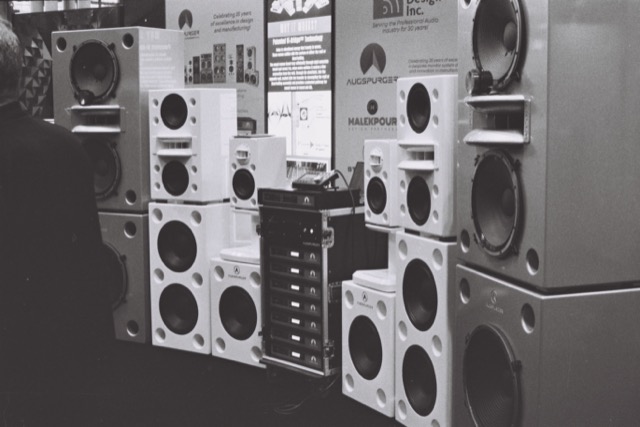
Speaker Control
RTW is a company from the Netherlands which has long built level metering and monitor controlling for the European broadcast market. European broadcasters are usually government-funded, have high technical standards, and are willing to do what is needed to support those standards. They have made a number of "monitor controllers" which are basically line preamps operating in the digital domain so that signals don't need an extra analogue conversion step.
The Touch Control 5 is a little bit different because it isn't just stereo and it can control as many as 32 channels. Audio comes in and out through a Dante interface, so even with a 16-speaker Atmos array you can control levels. For smaller systems, say 5.1 channels, you can switch multiple speaker systems to multiple sources, so you can monitor over theatre speakers or small home speakers as needed. It's got headphone outputs and you can route anything you want to the headphones. Very cool little arrangement and a handy tool to have in the upcoming multichannel world.

Headphones
ADV (adv-sound.com) was a local New York City company selling custom in-ear monitors and earplugs. They didn't have the ability to ear molds at the show, though, like some companies in the past, so you had to be in the city long enough to get molds made in town for you.
People doing binaural recording have noticed that the shoulders need to be part of the binaural head in order to get realistic height cues. But what about front-to-back cues? Don't they all come from the pinnae? In Investigation of the Impact of Spectral Cues from Torso Shadowing on Front-Back Confusion and Perceived Differences along Cones of Confusion, Sascha Dick and Juergen Herre from the Fraunhofer Institute discover that it's more than just the pinnae involved in the ability to image sounds accurately in front of and behind you. AES Convention Paper 10673.
The coming of object-oriented audio recordings means that headphone listeners will need rendering systems that take all of the individual audio streams and position them appropriately in the soundfield using a model of the listener's HRTF. A number of people I have spoken to have complained about the poor quality of the rendering systems being used, and in Binaural Renderers Accuracy Comparison, Part I. Lisa LaFontaine and others confirm that statement. All of the currently-available rendering systems rely on a generic HRTF of some sort rather than a custom one for each listener, and all of the systems that they surveyed performed very poorly at imaging in a simple listening test where subjects were asked to show the position of each test sound source on a map. Sad, but not surprising, and it shows that a lot more development into the rendering end needs to be accomplished before any of these systems gain real popularity. AES Convention Express Paper 173.

Not quite headphone material but related: Analysis of Musical Spectral Distortions as a Rating Mechanism for High-Fidelity Earplugs. Various musician-grade earplugs are available on the market, but how to tell which one is better? David A. Anderson at the University of Minnesota Duluth uses a simulated ear assembly to measure the frequency response alterations from various types of earplugs. This is the kind of work that industry should be doing but isn't, so I commend folks like this for stepping up and measuring. AES Convention Paper 10664.
Loudaholism
It's no news that people are upset with poor dialogue intelligibility in films these days, and there has been no shortage of discussion of this in the press. In Capturing Audience Film Sound Preferences, Ahmed Gelby and Iain MacGregor surveyed audiences about how they watched movies and how they felt about the sound levels and quality with different presentation arrangements. Clearly a mix designed for a cellphone will not work well in a movie palace and vice-versa. They did not present any actual media to people or get them surveyed immediately after viewing media, so the data is based on many combined earlier experiences. It still shows about what we would expect and that's a step toward quantifying common knowledge so we can really verify it properly. AES Convention Express Paper 170.
Microphones
Many of the usual vendors like Shure, Sanken, and Schoeps were there although I didn't see anything that amazed me. Josephson Engineering was sitting out the show this year unfortunately.

Independent Audio is the US distributor for a number of European products, including the Coles and Pearl microphones. Coles is still selling the same mikes they sold in the sixties (for which they should be proud) but Pearl had a number of new items including the Pearl ELM-T, which is a tube condenser microphone using their very long rectangular capsules, handmade in Sweden.
Microphone-related but different was Schulze-Brakel from Germany which makes a large variety of custom-imprinted microphone flags and windscreens. This is probably more for the NAB folks than the AES folks, but they were on the AES side and to be honest custom windscreens are a good plan for a lot more than just broadcasters. For PA and studio folks they can help keep smaller microphones from walking off accidentally when mikes from several sources are being used in one place. These guys usually exhibit along with Microtech Gefell, but Gefell was also very much missing from the show this year.
A company called Deity Microphones was selling some inexpensive wireless packs and shotgun microphones for entry-level video work. Again, this seemed more appropriate for the NAB show, but it looked like usable stuff and their shotgun was very, very light to make things easy on the boom operator.

Something that was very cool was that Derek Bargaehr from Vanguard Audio Labs was showing off a single point stereo microphone with four outputs so that by combining each pair, the directionality of each microphone could be adjusted remotely. This is a very useful concept for recordings where you can't necessarily make good placement decisions in the field due to limited monitoring ability. AKG did something like this with the C24, but the Vanguard V24 allows multiple outputs so the control can be done in post-production rather than by turning knobs on the power supply like the C24. In spite of the similarities, it is not a C24, even though it has tube electronics. This makes it worth checking out.

Interestingly enough, Austrian Audio was showing their OC818, which is a mono microphone derived from the AKG C414 line, which can be configure with two outputs for a similar arrangement of pattern control in post. When AKG laid off much of their staff after being purchased, many of them started up Austrian Audio which is making some excellent microphones of new design that are based on the AKG philosophies and models.
Down on the show floor, Matt Barnes from the Australian National University and Christoph Frank from Austrian audio were talking on Dynamic Polar Patterns: Advancing Recordist Agency via Dual-Output Microphones. I think this should have been an engineering brief rather than a paper, but this year there were no engineering briefs. The authors described the advantages of having independent equalization control over the front and back channels of the microphone, allowing interesting pattern control variations with frequency. It was more than just a puff piece for Austrian Audio and I am curious to try the system and see what degree of utility it really has in the field. AES Convention Paper 10665.
Converters
John LaGrou, who with the company Millennia Media has made fine mike preamps and converter for many years, is now starting a company called Imersiv which is building DACs for home audio as well as studio applications. He is using multi-path converters with autocalibration to match them, and getting true 27-bit performance. This means reverb tails clean to a point way below not just room noise, but below the acoustical noise of headphones in a quiet room.
He has a philosophy of wanting to be able to do all signal acquisition with a wide-dynamic microphone, do all level changes strictly in the digital domain where the noise and distortion of level pots can be eliminated, and then play back again through a wide-dynamic system. This is only the first step toward being able to do that but I think it is probably the most interesting and impressive product that I saw at the show this year.
He's been working on this product for many years, tweaking it to be just right, and like the rest of the industry had a major setback with the destruction of the AKM chip factory three years ago. But he's actually got products coming available for testing soon.
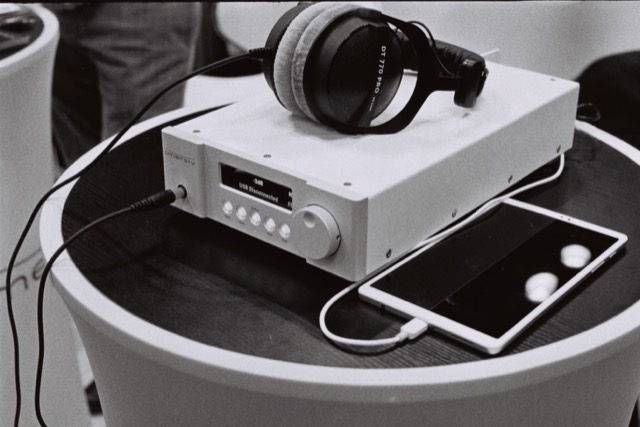
Incidentally if you are curious about the basic technology, he wrote a paper for the (cancelled) 2020 convention, called Dynamic Range in Digital to Analog Conversion via Multi-Path Topology which became AES Convention E-Brief 645. It's a good overall discussion of how the multi-path arrangement works.
Downstairs, an interesting paper was Comprehensive Objective Analysis of Digital to Analog Conversion in Consumer and Professional Applications by Amir Majidimehr of Audio Science Review. I was unaware of his website but it is quite popular in the audiophile community, and he has been using a simple Audio Precision test set to measure a huge variety of different DACs. Although I am a bit concerned at his almost-exclusive use of THD+N measurements in the form of SINAD numbers, as these measurements can mask closely-spaced sidebands induced by jitter, his reasoning for doing so was very clearly explained and he showed correlations with other measurements. If you are in any way curious about doing consistent measurements of DACs or really any audio gear, the paper is worth checking out. AES Convention Express Paper 124.
Sonifex was selling a very different sort of converter; they had boxes to translate dante audio-over-IP streams to and from analogue audio, AES/EBU, MADI, and HD video streams. All sorts of useful tools for working with the Dante world. Great stuff for recordists who have to interface with PA people and PA people who have to interface with the recording crew.
Wireless
On the subject of wireless, there was a panel called UWB - A New Wireless Tech in the Future of Pro Audio with a number of panelists from different places. It was high on politics but low on technology, but this is an important new thing that people should be aware of. This is a very low power spread spectrum system using everything from 3.1 to 10.6 GHz which trades power for bandwidth. Because the spectrum is so wide, interference from narrowband systems are minimized... but because the frequency is so high, body blocking is a problem for wireless microphones and headphones using the system. Because the spreading is so wide and needs to be so precise, the transmitter and receiver need very well-matched clocks to stay in synch and that is also a thing that needs more development. But this looks like a very promising arrangement for low-latency low power short-distance applications like wireless microphones and headphones.
The UWB Alliance is an organization set up to promote and standardize this stuff, and they had some presence there. Also a company called Spark was showing an IC called the SR1020 which was a complete UWB radio on a chip providing 96/24 audio with a 32/16 return channel for a headset mike.
Cables
Mogami was the only cable vendor there this year, with all the usual suspects absent from the show. Over on the NAB side, Nemal was showing fibre optic assemblies and cleaning products for field work. These guys do custom cables for the broadcast world and are good folks for everything from odd XLR cables to high end fibre stuff.
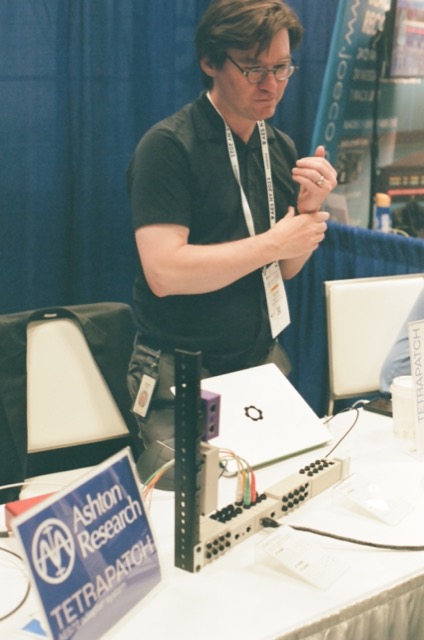
A company called Ashton Research was showing some gadgets called Tetrapatch which allow you to patch line level audio into RJ-45 connectors for sending around on inexpensive cable. Now that the AES-72 standard for audio-over-RJ45 exists, I think we will be seeing more and more of this. The tetrapatch is compliant with the new standard so can be expected to be useful for a long while.
Acoustical Supplies
Jocavi was there showing off an excellent line of diffusers and absorbers, and they have a very wide range of products that I have used many times. New to me, however, was MSL, a Canadian firm making a variety of noise control products including an inexpensive absorbing panel called SONOpan. Unfortunately the datasheet had no actual measurements but I am always interested in lower cost material to keep noise under control in noisy areas so they don't leak into studios or listening rooms.
ETS Lindgren was there showing doors and anechoic chamber supplies, as well as their small portable anechoic chamber for speaker and microphone measurements. Soundproof Windows was there showing sealed doors and windows for studio and listening room applications.
PSI Audio was showing their AVAA C214 active bass trap. This is a small active speaker device that acts as a broadband bass trap. The win here is that the unit itself is much smaller than an equivalently effective passive trap would be. There are very few of these available in the market and they are all pretty expensive but they can be a lifesaver in a tiny room where low end control quickly becomes a serious problem. There's often not enough room for proper bass trapping without using a device like this.
Processing
The same folks behind Telefunken USA are back with another interesting reproduction job. They bought out the old Fairchild Recording Equipment mark and are making a pretty solid looking Fairchild 670 reproduction. It has some good and bad points: Triad makes the original transformers which they use and which look good, and a lot of the Fairchild sound comes from that. But they are using 6386 replacement tubes which aren't really like the originals. To be honest, just about everyone is doing this because the supply of NOS tubes has dried up, but to my mind this is a real problem with anyone building or using a 670 reproduction or replica today. For that matter it's a real problem for people with original 670s. But this looks like a solid attempt at doing things right. If you are shopping for a 670 clone you should definitely compare them with this.
GC Audio from France was showing their Inherit system. This is a chassis with a bunch of different types of power supplies, which allow you to plug in various microphone preamplifier modules. You can plug in a tube preamp or a transistor preamp with or without transformers, and they were working on making an even larger variety of modules available. I am a bit worried about long-term reliability of such a thing since people are plugging stuff in and out and putting a lot of wear on those edge card connectors. Still, the idea is a useful one for someone who wants a wide variety of different preamps but doesn't need to use more than one at a time.
EveAnna Manley from Manley Labs wasn't there but Marek Stycos from Audio Alchemist was showing off her products and her leather pants. Manley has had a bunch of new stuff since the last time they were at a show, and while they didn't show any of the high end audio stuff (like the Manley Mahi tube amp that made the cover of Stereophile recently), they were showing off the Reference Silver microphone and the rest of their fine line of audio processing. They are also now selling a complete channel strip with a preamp, compressor, eq, and limiter all in one box, called the Manley Core.
Object-Oriented Audio
These days when people use the world "Immersive" they almost always mean object-oriented audio systems where the speaker placement is decoupled from the recording format. And when they talk about object-oriented audio they almost always mean Dolby Atmos. But there is competition! Meyer sound is selling a system called Spacemap Go which permits very sophisticated spatial sound design into a network of Meyer speakers and networked processors. Being Meyer, they are promoting this for theatre, concerts, and the like rather than for cinema, but I look forward to a future where there is data interchangeability between object-oriented audio systems. The Meyer demo was very effective no matter where in the room you were, but how to use this effectively at an event is still up in the air.
Studios
In Assessing Accessibility within the Recording Industry for Engineers and Producers with Vision Loss, Lachi Music (is that a pseudonym?) interviewed a small but diverse group of engineers who were blind or had some vision loss, about use of digital audio workstations. In the analogue days, just about everything other than meters could be used without vision; there was one control per function and it was always in the same place on the console. The patchbay slots always went to the same places and you could feel three holes from the left and patch into the compressor. With a DAW it is very different, and if you can't see the screen you're greatly limited. Even worse, the pointing device becomes difficult to use and so keyboard shortcuts become essential. I hadn't thought so much about this but as a person with somewhat limited vision who prefers using the keyboard (and who is upset that most of the tutorials are very mouse-oriented), it makes good sense. I would like to see much more research here on details of user interfaces that could be optimized for use without sight. AES Convention Paper 10682
.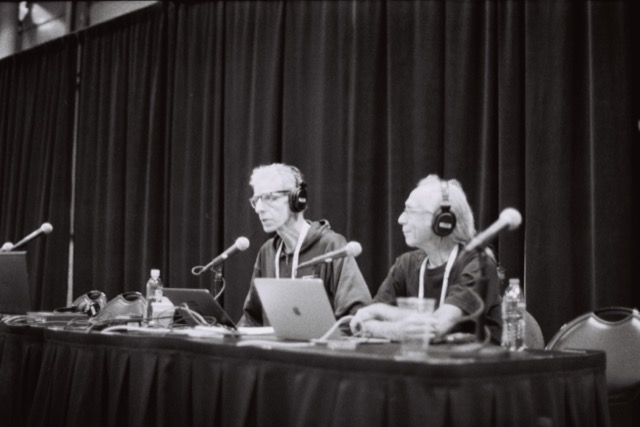
Mark Rubel, Dominick Costanzo, and Pete Weiss gave a panel discussion called Engineering the Sound of New York City's Columbia Studios. These were folks who had worked in the studio late in the life of the facility, and they gave a great talk with photos which was an interesting contrast to Dan Mortensen's talk at the 2017 AES show. I wish recordings of both of these could be made available together.
Josh Rogosin from the NPR Tiny Desk Concerts gave a talk on them but it was scheduled at the same time as the Jay McKnight memorial so I wasn't able to see any of it. I would like to have gone just to see what was up with those short shotgun mikes! There are always far more interesting events at the show than I ever get to attend.

Hard Disks
There were a number of computer companies on the NAB side and I think they should have had more presence on the AES side as well. Dell was there, but also some disk drive vendors.
I really liked the HGST conventional disk drives in the past, but as we move to SSDs, they are getting harder to find and I want a 2GB 2.5" disk with the highest reliability under high-write environments as possible for field recording applications. HGST is now owned by Western Digital and their drives in the WD Gold and Ultrastar lines include a model that is what I want... the sales rep told me that anything with "Helioseal" was from that line. I gather that the Ultrastar and Gold drives are the same products for different sales channels. Unfortunately I could not find any of the drives mentioned on the WD website so will have to give them a call.
I asked the Seagate folks the same thing, and they said that they are only doing 10krpm drives in 2.5" and that is fine by me since I don't need the performance of the 15krpm drives, I want reliability. They suggested the Enterprise Performance 10,000 series. They also said that their Ironwolf Pro and Exos drives are the same products for different sales channels. They suggested the Exos 10E2400 series, which turns out to be the ST2400MM0129 model.
I know this is kind of on the edge of the topic, but long-term rotating storage is an important issue for anyone archiving a lot of audio these days!
Components
The only transformer company there was Triad, and Triad makes some very cool stuff including a lot of vintage designs. Anything you want from the 1940s Triad catalogue they are willing to make with a big enough order, and since a lot of the more interesting vintage transformers have been set up already, the better ones are available onesie-twosies.
I very much missed Lundahl Transformers this year, who are usually set up on the show floor. THAT wasn't there although I did talk to Dennis Fink from THAT who has been really instrumental in some of their newer linear semiconductor designs.
Analog Devices was there but they did not in fact have anyone showing off their analogue line at all, just DSP. Most interestingly they were showing off chips for the A2B digital interconnect system, which allows 32 channels bidirectionally, plus power, through up to 100 ft of shielded single pair cable. These have I2C interfaces on the other end so they can be easily integrated with existing interfaces and converter chips. The A2B interface was originally intended for the automotive industry but they are attempting to expand it out to other markets. It's certainly cheaper to implement than MADI and more robust than Lightpipe, but I think MADI and Lightpipe are so heavily entrenched in the industry at this point that a newcomer is going to have a hard time of it.
They were also showing a class D amplifier that was developed by their Maxim division, called the MAX98415. A lot of power in a square inch of board space with no heatsinking. Not exactly high end audio stuff but it's a step forward and moving the operating frequency on these amplifiers up and up gets them closer to the point where they might become high end audio stuff someday.
Neoden USA was showing an inexpensive tabletop pick and place system, which combined with their (or some other) SMT oven forms a complete surface-mount board production system. As a small manufacturer I am very pleased to see folks like this exhibiting at the show.
Michael Chandler-Page from Cirrus Logic talked about Exploiting 55nm Silicon Process to Improve Analog-to-Digital Converter Performance, Functionality, and Power Consumption. This paper was short on technical details and long on marketing but it had one really important and interesting point. It seems Cirrus Logic has a new mixed-signal process that has higher resolution. This permits smaller transistors (and therefore more transistors) on the digital side, and better capacitors (at least with better matching, although they wouldn't talk about any other parameters) on the linear side. The most important part here is the digital side, where they were able to beef up the digital filters for the ADC using entirely IIR filters and much longer coefficients and accumulators, for higher precision filtering without spurious tones. On the analogue side the better capacitor made for much better performance of the switched capacitor sampling-- you can think of this as a sample and hold that delays the signal and then compares the delayed signal with the current state of the signal to determine if it is rising or falling. Clearly the capacitor used to hold that signal and the leakage of the switch feeding it are paramount. The paper is worth checking out but doesn't give enough detail into what is actually going on with the new technology. AES Convention Express Paper 185.
Dealers
Two major dealers had booths. Dale Pro Audio, which handles a lot of broadcast gear as well as general pro audio gear, had a booth. Markertek Video Supply, which is a great place for a lot of pro audio bits and pieces, also was there. Markertek was giving out rulers with templates for various connectors which I think was the best free giveaway this year.
Student Stuff
My first trip to the AES was prompted by Dr. Marshall Leach who was an EE professor at Georgia Tech when I was a student there, and who told everyone how important the AES was. This year I was pleased to see Alexandra Smith from the School of Music there. Although I am staggered at the idea of Tech offering any degree not requiring a thermodynamics class and memorization of steam tables, I was delighted to see her enjoying the show and bringing ideas back for a new generation of students to bring them into the fold.
The folks who run the audiopronetwork.com industry social media website now are running the "Audio Post Accelerator" which is a sort of virtual internship for audio post production. There's a big demand for people who can do audio post work, but very few organizations that want to train up new people. I don't know how well this program does at teaching the social stuff which is an important part of any studio work, but it's certainly better than nothing. And nothing is all that is available for a lot of kids who want to get into the industry.
Tours
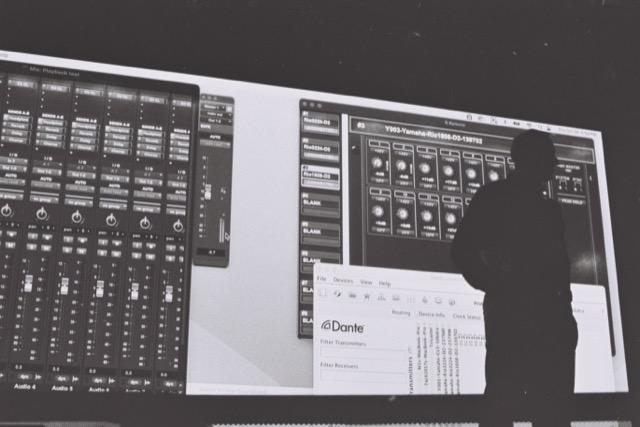
Every year there are a number of tours to local facilities, and while I missed the tour of the new upgraded Geffen Hall, I did get on the tour of the United Palace Theatre. This was originally a movie palace from the age of silent films, but in 1969 it was purchased by Reverend Ike to use as a huge megachurch. It stayed that way until 2012 when it became a live concert venue. What is most interesting is that the hall was never abandoned or left empty and it has been in continuous use. No restoration has been done, but careful maintenance has been taking place so that there really has been very little damage over the years. The reverb time is a bit long for amplified music because some of the original absorptive panels need some updating, but the hall looks immaculate. There is a modern line array PA with a Yamaha console and a Dante system. I would love to have heard more about the Dante arrangement and how that was integrated with the broadcast trucks at the Tony awards this year, but we actually got very little time with the tech folks unfortunately. They mentioned that most of the original film projectors were still up in the booth (along with a modern DLP system of unknown resolution) but we didn't get a booth tour or any real info about what was left. The tour was great but it left me wanting to know more about what was backstage. After years of playing Reverend Ike's tapes on the radio as a kid, I was pleased to finally see the room and that it was just as grand and amazing as Rev. Ike had said it was.
Unusual Stuff
A company called "Froggy's Fog" was selling some fog machines but more interestingly they had a fog fluid which they claimed had little or no residue and the lowest amount of glycol possible. I am not sure why this is at the AES rather than the NAB, but as a guy who has had to remove fog residue from microphones many times, I can say this is welcome. Nothing worse to remove from a condenser microphone diaphragm than glopped-up fog machine goo.
And there was a company called mycasebuilder.com which has an online gadget that allows you to lay out custom foam inserts for cases. They will sell you the empty case, or the foam insert for your case, or a case with a foam insert. Everybody needs this stuff no matter what they are doing; pro audio folks, photographers, and people who carry a turntable around to hotels with them. They also do logo printing on foam! How cool is that?
We Are Moving the Needle (wearemovingtheneedle.com) is an organization set up to try and make the audio industry more gender-inclusive. It provides support and resources for women to help get into the industry as well as to keep them there. (And yes, they are inclusive to the nonbinary community as well.) They offer scholarships and grants and are starting to have college campus chapters. I wasn't able to find out much about the college chapters or their impact but any organization providing support to anyone getting into the industry gets a thumbs-up from me.
There was a panel discussion on the history of the AES, The Evolution of the AES - Celebrating the First 75 Years with some distinguished AES members but also some videos from the 50th anniversary of the AES, all those years ago. The video interviews with Norman Pickering about starting the organization were the best part, as Pickering is one of those people that I remember as being significant old-timers when I started coming to the show.
Also historical was a panel in memoriam of Jay McKnight, with his two sons and Brad McCormack. Jay did so much of the original mathematical analysis of the analogue tape machine and head interface, and for many years after his retirement from Ampex in 1972 he ran Magnetic Recording Laboratories which was often the only provider of alignment tapes and materials for audio recorders. He also had some fame as one of the people on the advisory panel on the Nixon white house tapes. He was a person who would always help out anyone with tape machine questions or problems no matter who they were and how experienced they were. He will be missed.
There was also a panel of people talking about the Saul Walker Student Design Competition. I think the design competition is one of the most important things that the AES does for the university community because it is a way to get EE students into the AES and it is a way to get audio students to start thinking like EEs.
On the NAB side, A company called Tulix was showing off a content delivery network for realtime live streaming. I discussed with them the possibility of streaming high-grade uncompressed audio, and they said that their system had the ability to trade-out codecs for any one supplied. A system able to delivery high quality video to a large volume of customers should be able to handle quite a lot of audio signal.
Also on the NAB side I was talking to a company called Fluotec which makes LED lighting for video and cinema work. In addition to the common soft panels they make some fresnel fixtures that behave a lot like old-style tungsten and HMI fresnels. Not really relevant to audio but I spent some time talking to the guys and liked them. As a fan of Hollywood-style hard lighting which today has become so rare, it is good seeing these sorts of lighting instruments being made.
Magazines
What happened to all the magazine vendors? Normally we have stacks and stacks of different audio magazines from all around the world, and that is a lot of fun. This year there was AudioXPress and Recording... I didn't even see Sound on Sound although I know there was a representative attending. Not even Resolution. What happened? It's as if something went badly wrong here.
Conclusion

Things are starting to come back from Covid and the AES seems to be regrouping and having the show run by a new organization that seems a bit confused about the dual nature of the show. But the show was better than it was last year in pretty much every way and if it wasn't up to the level of the great shows of the eighties and nineties, that's not the fault of the AES but the industry. The show is definitely on the way up and you should make every attempt to support it because it's just not like any other conference or trade show out there.








